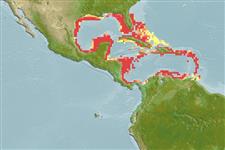Issue
Included in the synonymy of Ogcocephalus cubifrons, but as a nomen dubium in the genus Ogcocephalus (Bradbury 2003, Ref. 50473); additional comments following the synonymy (Bradbury 1980:258-259, Ref. 40824). Please send references, or more studies are needed.
Environment: milieu / climate zone / depth range / distribution range
Écologie
marin démersal; profondeur ? - 70 m. Subtropical; 30°N - 9°N, 98°W - 60°W
Western Atlantic: southeastern Florida, USA and northeastern Gulf of Mexico to Campeche, Mexico. The name Ogcocephalus cubifrons has been misapplied to this species (Ref. 3814).
Taille / Poids / Âge
Maturity: Lm ? range ? - ? cm
Max length : 38.0 cm TL mâle / non sexé; (Ref. 7251)
Occurs from water's edge to 70 m depth.
Life cycle and mating behavior
Maturities | Reproduction | Spawnings | Egg(s) | Fecundities | Larves
Robins, C.R. and G.C. Ray, 1986. A field guide to Atlantic coast fishes of North America. Houghton Mifflin Company, Boston, U.S.A. 354 p. (Ref. 7251)
Statut dans la liste rouge de l'IUCN (Ref. 130435)
Menace pour l'homme
Harmless
Utilisations par l'homme
Outils
Articles particuliers
Télécharger en XML
Sources Internet
Estimates based on models
Preferred temperature (Ref.
123201): 23.4 - 28, mean 26.4 °C (based on 262 cells).
Phylogenetic diversity index (Ref.
82804): PD
50 = 0.5001 [Uniqueness, from 0.5 = low to 2.0 = high].
Bayesian length-weight: a=0.00389 (0.00180 - 0.00842), b=3.12 (2.94 - 3.30), in cm total length, based on all LWR estimates for this body shape (Ref.
93245).
Niveau trophique (Ref.
69278): 3.5 ±0.6 se; based on size and trophs of closest relatives
Résilience (Ref.
120179): Faible, temps minimum de doublement de population : 4,5 à 14 années (Preliminary K or Fecundity.).
Fishing Vulnerability (Ref.
59153): Low to moderate vulnerability (28 of 100).
